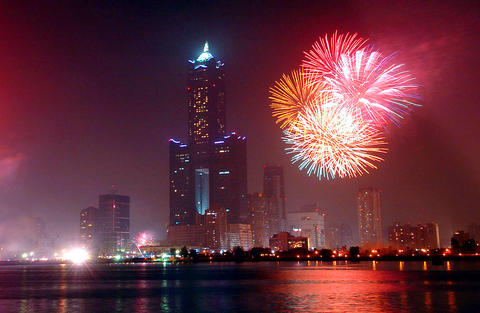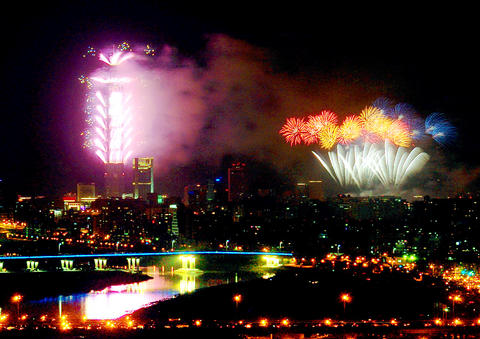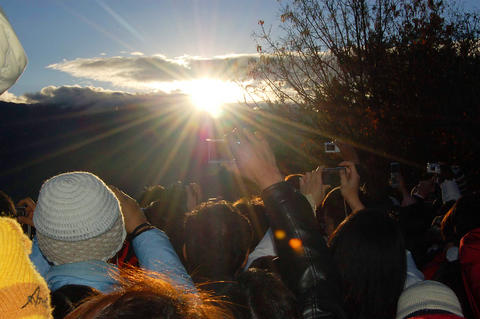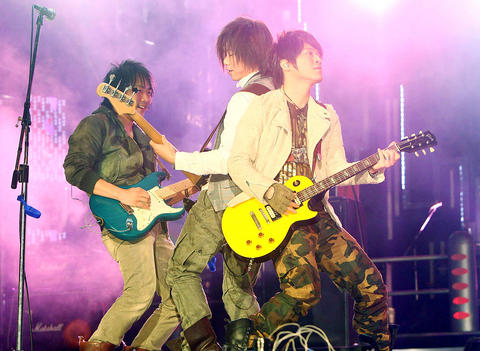New Year's Eve is just around the corner. There's so much to do, and so little time to do it. From fireworks displays and star-studded concerts to festivities spiked with local flavors, Taiwan will be full of events where you can watch the ball drop without dropping the ball.
Taipei City will once again be the scene of the country's biggest pyrotechnics display - and its biggest plume of smoke - when Taipei 101 turns into a giant firecracker launchpad at midnight. A record-breaking number of spectators is expected to turn up for the show this year and watch 12,000 fireworks shoot into the sky.
The management of Taipei 101 has hinted that the skyscraper, which is nearing full occupancy, may stop hosting the explosive spectacle next year because of lack of funding and the difficulty of securing permission from all of the building's tenants.

PHOTOS: TAIPEI TIMES
If you plan on being anywhere near Taipei 101 in the Xinyi District on Monday, it's best to get there early. While you wait, there will be a pop concert in front of Taipei City Hall that starts at 7pm and runs to the stroke of midnight. The lineup includes familiar faces such as singers Jolin Tsai (蔡依林), Alan Luo (羅志祥), Jasmine Leong (梁靜茹) and Tanya Chua (蔡健雅), as well as rock bands Mayday (五月天) and Champion (強辯).
Other events in the area include a carnival-like parade of 600 performers and floats that will run through the streets of the Xinyi District near Taipei City Hall between 2pm and 5pm on Sunday. Also in the vicinity, the finals of the third annual MRT Cup Pop Music Contest (捷運盃熱門音樂大賽) are being held at the Shinkong Mitsukoshi (新光三越) complex.
Malls in the area around Taipei 101 will extend their business hours to accommodate the crowds on New Year's Eve. Both Neo 19 and New York, New York will remain open until midnight. New York, New York's food court will operate until 1am, and the food court at Taipei 101's shopping mall will not shut its doors until 2am.

Four temporary bus stops are being set up to deal with the massive exodus after the countdown, and the MRT's trains will run all night. A word of advice for those planning on taking a car or motorcycle: Don't even think about it unless you don't mind getting stuck in traffic for hours.
Moving south, Kaohsiung City will be hosting a New Year's Eve party that kicks off at 7pm at its Star of the Sea pier area. Performances will feature mainstream and indie acts, including Wang Lee-hom (王力宏), Soda Green (蘇打綠), The Chairman (董事長), Faith Yang (楊乃文), Dog G (大支) and Cyndi Wang (王心凌).
Kaohsiung residents can then ring in the New Year Eve with La Fura dels Baus, the renowned Spanish theatrical group whose boundary-blurring productions have earned it worldwide attention.

For its Kaohsiung debut, La Fura dels Baus promises a visual and audio extravaganza staged on the Naumon, a converted ice-breaker the troupe has used as a floating theater since 2004 for performances in port cities around the world. La Fura dels Baus's one-hour show starts at 10pm on New Year's Eve.
On the east coast, Taimali (太麻里), also known as the "Town of Sunrise," will host a sunrise watch party on its beach. Festivities are scheduled to begin at the National Museum of Prehistory (國立台灣史前文化博物館) in Taidung City and will feature performances by Aboriginal musicians Beiyuan Shanmao (北原山貓) and Kao Hui-chun (高慧君), as well as rap act Nan Quan Mama (南拳媽媽).
The celebrations continue later at Taimali beach, with groups of hip-hop artists and street dancers performing through the night. Shuttle buses will run between the museum and the beach starting at 1am.

Instead of a countdown, there will be a concert held at sunrise at the Jhushan Sunrise Viewing Platform (祝山觀日平台). Scheduled acts include musicians from the Tsou tribe (鄒族), the Taipei Philharmonic Chamber Choir (台北愛樂室內樂團) and folk musicians The Southern Duo (南方二重唱).
For a more off-beat way to ring in the New Year, check out the retired steam locomotive at Alishan (阿里山) that will be briefly brought back into service from tomorrow until New Year's Day. In celebration of its 96th birthday, the antique train will run with four carriages made from Taiwanese cypress between the Alishan Station and Shenmu Station, from 8:30am to 3:30pm each day.

President William Lai (賴清德) yesterday delivered an address marking the first anniversary of his presidency. In the speech, Lai affirmed Taiwan’s global role in technology, trade and security. He announced economic and national security initiatives, and emphasized democratic values and cross-party cooperation. The following is the full text of his speech: Yesterday, outside of Beida Elementary School in New Taipei City’s Sanxia District (三峽), there was a major traffic accident that, sadly, claimed several lives and resulted in multiple injuries. The Executive Yuan immediately formed a task force, and last night I personally visited the victims in hospital. Central government agencies and the

May 26 to June 1 When the Qing Dynasty first took control over many parts of Taiwan in 1684, it roughly continued the Kingdom of Tungning’s administrative borders (see below), setting up one prefecture and three counties. The actual area of control covered today’s Chiayi, Tainan and Kaohsiung. The administrative center was in Taiwan Prefecture, in today’s Tainan. But as Han settlement expanded and due to rebellions and other international incidents, the administrative units became more complex. By the time Taiwan became a province of the Qing in 1887, there were three prefectures, eleven counties, three subprefectures and one directly-administered prefecture, with

Among Thailand’s Chinese Nationalist Party (KMT) villages, a certain rivalry exists between Arunothai, the largest of these villages, and Mae Salong, which is currently the most prosperous. Historically, the rivalry stems from a split in KMT military factions in the early 1960s, which divided command and opium territories after Chiang Kai-shek (蔣介石) cut off open support in 1961 due to international pressure (see part two, “The KMT opium lords of the Golden Triangle,” on May 20). But today this rivalry manifests as a different kind of split, with Arunothai leading a pro-China faction and Mae Salong staunchly aligned to Taiwan.

As with most of northern Thailand’s Chinese Nationalist Party (KMT) settlements, the village of Arunothai was only given a Thai name once the Thai government began in the 1970s to assert control over the border region and initiate a decades-long process of political integration. The village’s original name, bestowed by its Yunnanese founders when they first settled the valley in the late 1960s, was a Chinese name, Dagudi (大谷地), which literally translates as “a place for threshing rice.” At that time, these village founders did not know how permanent their settlement would be. Most of Arunothai’s first generation were soldiers